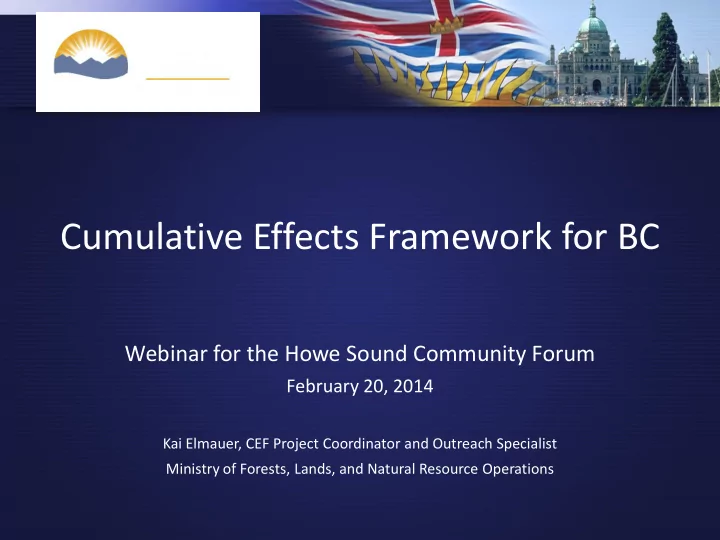

Cumulative Effects Framework for BC Webinar for the Howe Sound Community Forum February 20, 2014 Kai Elmauer, CEF Project Coordinator and Outreach Specialist Ministry of Forests, Lands, and Natural Resource Operations
Content – Based on questions we heard CE framework and CE assessment – what is relevant for Howe Sound? Boundaries - is it feasible to assess cumulative effects in Howe Sound? Jurisdictions - who could/should be involved? What would be the roles and responsibilities for everyone involved? = Would an assessment of cumulative effects be of value for Howe Sound? From commitment to action – what next steps could be taken to start this?
Cumulative Effects – Problem and Solution Definition Problem Solution Benefit Cumulative effects “changes to Considering only project assessment and Better outcomes for environmental, social or sector specific effects management as an values, more efficient, and economic values of natural resource caused by the combined integral part of transparent and development allows effect of past, present ‘Integrated Decision - consistent decision- unintended impacts to and proposed Making’ for the natural making accumulate over time activities and events” resource sector
CE Framework - Supporting CE Assessment 1. Broad Scale CE Assessment -land use planning sub-regions -periodic assessment (3-7 years) 2. Common values (all sectors) -environmental, social, economic -provincial (core set) & regional 3. Assessment relative to objectives -current condition and potential future 4. Open access to CEA data (maps, reports) - common baseline for all clients , SDM’s -better up front info for applications 5. Process for Managing CE - regional interagency review & direction for mitigation
Boundaries – Is it feasible to assess CE in Howe Sound? Administrative unit Value Value Value Value
Initial Values Initial Values • Forest Biodiversity (old & mature seral) • Riparian Condition • Water Quantity and Quality Criteria for Selection • Air Quality Existing Objectives (Legal & Policy) • Cultural Heritage Support for Aboriginal/Treaty Right • Visual Quality • Resource Capability (e.g. timber) Coarse filter/represents nested values • Economic Wellbeing Spatially mappable • Social Wellbeing Available data • Priority Fish and Wildlife Species (e.g. caribou, mule deer, moose, marten, grizzly bear) • Marine values TBC
CE Assessment Assessment relative to existing objectives for values Assessment of • Current condition • Potential future condition - foreseeable future (5-10 years) - long-term scenarios (50-100 years) – as needed 7
Example Assessment Result Risk Mapping & Trends Grizzly Bear Population - Mortality Risk Grizzly Bear Mortality Risk 2012 % Sub-pop Unit with Road Density above 1 0.9 recovery plan guideline 0.8 0.7 0.6 Risk to Value 0.5 High 0.4 Otter Mod-High 0.3 Similkameen Moderate 0.2 Tulameen 0.1 Low-Mod 0 Low Year: 2002 Year: 2012 Year: 2022 8
Socio-Economic Values Social Wellbeing • Population - Change & Composition • Education Attainment • Employment • Family Income • Housing • Community Participation • Community Social-Ecological Economy Economic Wellbeing • Employment • Labour Demand • Labour Supply • Economic Diversity • Revenue to Crown • Financial Capital • Infrastructure Capital
What are roles and responsibilities? What values are assessed? Values & What are condition & trend? Objectives What does it mean to us? CE Assessment What could be done? Decision Support Everyone makes informed decisions
From Assessment to Management Risk to Value / Management Possible Management / Meeting Objectives Approach Mitigative Actions • Strategic direction High - New / revised objectives Intensive - Strategic planning • Common permit conditions • Mitigation Plan • Research/ inventory Flexible • Apply best practices / Low Streamline decision-making
What next steps could be taken? Values & Objectives CE Assessment Decision Support
Contact Email: CumulativeEffects@gov.bc.ca Leah Malkinson, Project Manager, MFLNRO Leah.Malkinson@gov.bc.ca Kai Elmauer, Project Coordinator, MFLNRO Kai.Elmauer@gov.bc.ca
Recommend
More recommend